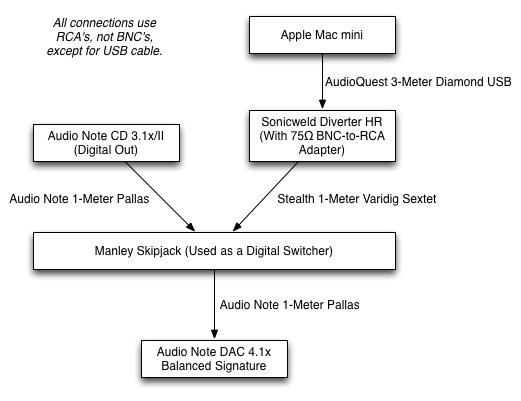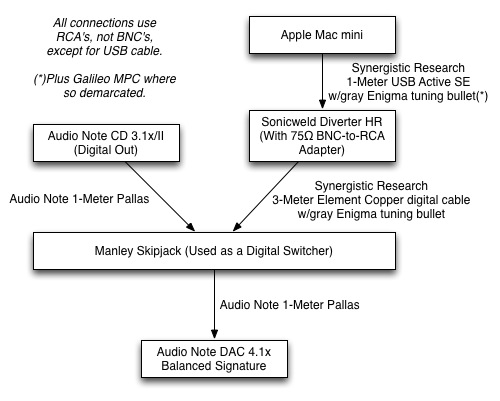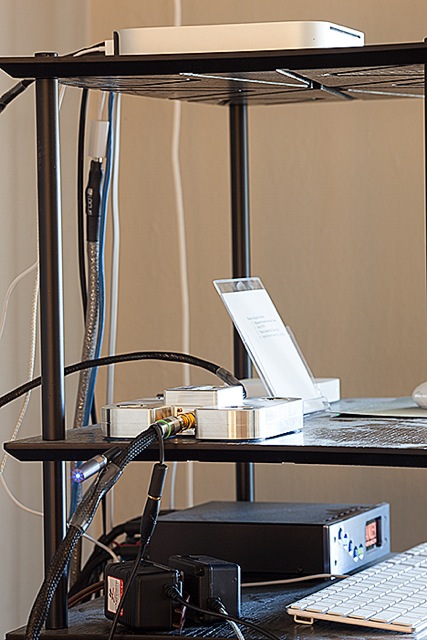You are reading the older HTML site
Positive Feedback ISSUE 72
Musings on Building a Digital Music Server: The
AudioQuest Diamond USB and Stealth Varidig Sextet versus the Synergistic
Research USB Active SE and their Element Copper, All with a Manley Skipjack
"Listen as the wind blows from across the great
divide —"Possession", Sarah McLachlan This does look back a long time. After a conversation with Josh Heiner of Sonicweld about my new Audio Note DAC 4.1x Balanced Signature and how I was fooling it into thinking that my five-meter Apogee Wyde-Eye WE-RR digital cable carried an AES/EBU signal as opposed to a S/PDIF signal by using a Cardas RCA-to-XLR adapter, all so that I could plug my Audio Note CD 3.1x/II (in use as a transport) and my digital music server into the DAC at the same time, I came to the conclusion that it might technically function, but that I was getting substandard sound. I came to this conclusion by rotating around the DAC 4.1x (no small task I assure you) so that I could unplug the Audio Note Pallas digital interconnect going into the DAC and replace it with the Wyde-Eye WE-RR so that my music server fed directly into the S/PDIF input of the DAC. Well, of course, everything did sound a lot better and this put me on a quest about how to have equal quality connections from both the CD transport and the music server going into the DAC, preferably through a switch of some type.
After putting together several cheap prototypes, realizing that my all-RCA based system meant that I could use a Manley Skipjack as a digital switcher if that would actually work, talking to both Manley and to many digital audio luminaries including my friend Nick Gowan at True Sound (who admittedly knows a lot about S/PDIF cables but not very much about computers or USB), and taking into account that one of my two cables—either the USB or the S/PDIF—was going to have to be three meters as opposed to one meter long, I finally settled on the following arrangement:
This gave me pretty much everything I wanted, got rid of the power extension cord required for the USB Active SE cable (much as I loved that USB cable) and provided a much more neutral, much more artifact-free sound from the digital music server not to mention that it in no way diminished the sound coming from the CD 3.1x/II. It also made me realize that I didn't have to downsample everything to 44.1kHz, but that 24/44.1, 24/48, 24/88.2, and 24/96 were supported as well. So I only needed to downsample something if it proved to sound better or it came to me at 24/176.4 or at 24/192, all of which I could live with. Of course, this all came at a price. Even the Skipjack had to be purchased as NOS (New Old Stock) from Acoustic Sounds at full retail because Manley doesn't make them anymore. The same thing was essentially true of the three-meter AudioQuest Diamond USB, which I got from Music Direct, but for a different reason. Basically, none of the manufacturers wanted to loan me three-meter USB cables because they were convinced that a one-meter USB with a three-meter S/PDIF cable was the only way to go. In fact, Peter Hansen at Synergistic Research was so sure of this that he loaned me a custom-made three-meter Element Copper S/PDIF cable with RCA connectors to use with his USB Active SE cable, in both cases using a gray Enigma tuning bullet but only in the case of the USB cable using a Galileo MPC:
This required putting the extension cord back out for the walwart-powered dielectrics and putting the Sonicweld Diverter HR back on the music server stand as opposed to the top of the CD 3.1x/II, which is where it sat when I used the long AudioQuest USB cable and short Stealth S/PDIF cable, all of which is fine. I let that combination play several albums just to allow it to break it a bit, then started getting to the tougher material, like the 24/48 downsampling of The Köln Concert that I had made from the 24/96 of that title I had bought from HDtracks.com and which definitely had something wrong with the high frequencies. I'm currently waiting for a response from ECM Munich on the matter, having written to ECM New York. There's no doubt that the Synergistic Research combination sounded very enjoyable and musical and that the USB Active SE continues to be among my favorite standalone USB cables; however, the USB Active SE/Element Copper combination couldn't quite reach the heights of the Diamond USB/Varidig Sextet combination, taking into account the various lengths and all; and I just felt that the AudioQuest/Stealth combination had fewer digital artifacts and less overall distortion, for a price, though.
The retail price of the one-meter Stealth Varidig Sextet costs around $3K by itself, and the three-meter AudioQuest Diamond USB costs about $1K. That's $4K worth of cables. If you look on, for example, the Cable Company's website, the cost of the one-meter Synergistic Research USB Active SE, plus the Galileo MPC, plus the three-meter Element Copper digital cable comes to a total of just about $3K. So there's a $1K difference (approximately), which explains some of the reason that the AudioQuest/Stealth combination sounds better to me than the all-Synergistic Research combination; but it doesn't explain everything. I mean, don't get me wrong, the USB Active SE (with the Galileo MPC) and the Element Copper sounded really lovely and did possess no small amount of magic. It's just that there's something extraordinarily neutral and quiet (and artifact free) about the AudioQuest/Stealth combination, allowing me to focus on the sound quality of the individual downloads and even manipulate their sample rate to get the optimal sound from a given set of files. I'm even thinking of getting a copy, at least a trial copy, of iZotope RX™ 3 just to see what I can do in terms of repairing the sound of certain sets of files in my library. Yes, while I would say I have some software learning to do to get the same sound quality as I do from my Audio Note CD 3.1x/II used as a transport, at least I think I have the hardware side resolved and I am able to more fully appreciate the 48, 88.2, and 96kHz sampling rates that my DAC can support, and support well it does. Kindest regards, Andy http://www.audioquest.com/usb-digital-audio/diamond http://www.interlinkhouse.com/products/Sextet/index.html http://www.synergisticresearch.com/
|


.jpeg)


